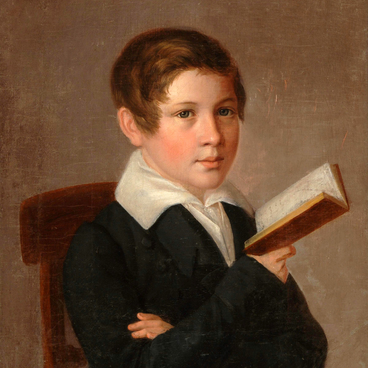The picture came to the museum collection in 1920 from Fetinino, the Zubovs’ family estate. The names of the author and the characters of the double portrait were unknown, and the specialists had to carry out assiduous work to discover some information about the canvas.
The aristocratic face of the elderly man and his expensive and prim clothes warranted the assumption that the painting featured a representative of the large Zubov clan. The family was held in great respect in the 18th and 19th centuries: Platon Zubov was the last favorite of Empress Catherine the Great, his brother Nikolai was married to the only daughter of Alexander Suvorov, a famous military leader, and later took part in the conspiracy to assassinate Emperor Paul I. These are just a few significant members of the Zubov family, which also had famous politicians, courtiers and collectors in its midst.
The specialists were able to infer which Zubov was depicted by the painter when they turned their attention to the other character in the painting. For 75 years, the Zubov family was home to Ivan Yakubovsky, a Polish nobleman, who had been brought to Moscow by Nikolai Zubov in 1789. He wrote in his memoirs: “When I was 19, my height was one arshin and four inches (i.e. about 89 cm. — The museum”s note).
From the book, the researchers found out that at first Yakubovsky was in the service of the mother of the Zubov brothers, Nikolai and Platon. Afterwards, the latter brought him to Fetinino, where Yakubovsky often went out hunting with his patron.
The specialists concluded that it is Platon Zubov who is the main character of the portrait. When he made his first appearance at court, contemporaries spoke about him with some degree of amiability. They noted that Zubov spoke excellent French, was quick-witted and very handsome. However, as the count’s influence at court grew, the attitude of the courtiers and society to him changed. He was called a ‘mediocrity, ” a “blockhead, ” “bold on the verge of impudence, haughty to the point of arrogance.” When Paul I ascended the throne, he stripped the favorite of his mother, Catherine the Great, of 36 offices with a stroke of a pen.
Here is what was written about Zubov in his old age: “Zubov was imperious in his youth, and in his old age, he changed, as much as it was possible, for the worse. His main passion was stinginess that went as far as miserliness. He lived infinitely below his means; when he was in good temper, he was deep in thought and glum. At 50, gray-haired, hunch-backed, he looked like a decrepit old man.”
The aristocratic face of the elderly man and his expensive and prim clothes warranted the assumption that the painting featured a representative of the large Zubov clan. The family was held in great respect in the 18th and 19th centuries: Platon Zubov was the last favorite of Empress Catherine the Great, his brother Nikolai was married to the only daughter of Alexander Suvorov, a famous military leader, and later took part in the conspiracy to assassinate Emperor Paul I. These are just a few significant members of the Zubov family, which also had famous politicians, courtiers and collectors in its midst.
The specialists were able to infer which Zubov was depicted by the painter when they turned their attention to the other character in the painting. For 75 years, the Zubov family was home to Ivan Yakubovsky, a Polish nobleman, who had been brought to Moscow by Nikolai Zubov in 1789. He wrote in his memoirs: “When I was 19, my height was one arshin and four inches (i.e. about 89 cm. — The museum”s note).
Everybody fell in love with me, I was vivacious and agile, and not at all ugly.” In the 20th century, Yakubovsky’s memoirs were published under the title The Favorite’s Dwarf. The Life Story of Ivan Andreyevich Yakubovsky, the Dwarf of His Serene Highness Platon Aleksandrovich Zubov, Written by Himself.
From the book, the researchers found out that at first Yakubovsky was in the service of the mother of the Zubov brothers, Nikolai and Platon. Afterwards, the latter brought him to Fetinino, where Yakubovsky often went out hunting with his patron.
The specialists concluded that it is Platon Zubov who is the main character of the portrait. When he made his first appearance at court, contemporaries spoke about him with some degree of amiability. They noted that Zubov spoke excellent French, was quick-witted and very handsome. However, as the count’s influence at court grew, the attitude of the courtiers and society to him changed. He was called a ‘mediocrity, ” a “blockhead, ” “bold on the verge of impudence, haughty to the point of arrogance.” When Paul I ascended the throne, he stripped the favorite of his mother, Catherine the Great, of 36 offices with a stroke of a pen.
Here is what was written about Zubov in his old age: “Zubov was imperious in his youth, and in his old age, he changed, as much as it was possible, for the worse. His main passion was stinginess that went as far as miserliness. He lived infinitely below his means; when he was in good temper, he was deep in thought and glum. At 50, gray-haired, hunch-backed, he looked like a decrepit old man.”

